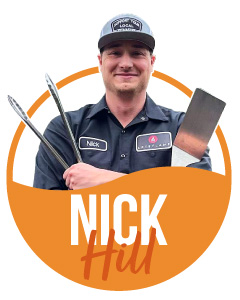Benefits Of Infrared Grills

If you’re thinking about upgrading your current grill, then you’re probably torn between going the gas or the charcoal way. However, there’s a third option you might not be aware of: The infrared grill.
Infrared grills are not as new as you may think. The first grills were produced in the year 2000 after a four-decade-long patent to the infrared burner expired. This effectively paved the way for manufacturers to use the technology to build infrared grills.
But what’s all the hullabaloo about? Here’s everything you need to know about the benefits of infrared grills.
What Are Infrared Grills: A Brief Overview
Infrared is a type of radiation that forms part of the electromagnetic spectrum. It's the same type of radiation that your TV-remote uses to connect when you want to change the channel. At short wavelengths, you can’t see it nor feel it, but at longer wavelengths, it emits heat.
An infrared grill and gas grill both use the same fuel source – natural gas or propane. However, the difference between the two grills lies in the way the heat is generated to cook the food. Here’s how.
In a gas grill, the cooking surface is heated directly by flames produced by a gas burner underneath it. In an infrared grill, on the other hand, the flame heats an infrared element which then generates infrared radiation which in turn cooks the food. The infrared radiation is the direct heat source.
You’re probably thinking – why not just heat the food directly like in a conventional grill? Using a gas burner to heat an infrared element, which then heats the food, seems counterintuitive. You might be right. But then again, it will all make sense once you understand why it needs to happen that way.
Benefits Of Infrared Grills
There are several benefits of infrared cooking that make it a far more superior grilling method compared to conventional gas grills. Here are some of the top benefits of infrared grills.
Even-Heat Distribution
Achieving uniform heat distribution across the cooking surface in open flame grilling can be frustrating, to say the least. Gas burners use a heat distribution system that relies on flame tamers, heat plates, briquette trays, heat tents, etc. These work to disperse the heat produced by the burner throughout the grilling surface.
Unfortunately, more often than not, this is not an exact science, and cold spots will inevitably occur. Infrared burners, however, rely on uniform radiant energy to heat the food directly. This isn’t concentrated on one part of the cooking surface. It spreads evenly across the grilling area.
Preheats Quickly
If you've ever worked on a conventional or traditional grill, then you know how it typically takes at least 20 minutes to heat up. For those who are on a time crunch or just do not have the time available, who wants to wait around on a grill in the middle of a busy weeknight when all you want to do is eat, unwind, and prepare for the following day?
Infrared grills, however, don't have this problem. Depending on the brand and model, most infrared grills take between two and five minutes on average to heat up, which is right up there with microwave cooking – except that it’s a grill and that food tastes way better!
Superior Flavor
Speaking of taste, truth be told: It’s every griller’s dream to achieve (or even surpass) restaurant-quality food every single time right there in their backyard. Achieving consistent results using a gas or charcoal grill can be difficult to do. It’s impossible to replicate the exact conditions that were present on a night when your grilled steak was simply out of this world.
Infrared grills, however, achieve the same level of consistency time and again. That aside, the food tastes more flavorful than it does when using conventional gas grills. The high heat sears the meat perfectly, caramelizing the surface and locking-in the natural juices.
Cooks Food Fast
Charcoal and gas grills cook food through convection, which means hot air is heated, forcing the hot air to rise to the top. The cold, denser air will sink to the bottom where the heat source is located and will also be heated before rising to the top as well. This process goes on until the food is cooked.
In infrared cooking, however, consistent heat is given off by the infrared element. The surrounding air temperature does not affect the heat intensity. So higher temperatures are achieved in half the time and maintained throughout. Food cooks faster as a result.
Minimizes The Chances Of Flare-Ups
The heat generated by infrared radiation is so intense that it instantly vaporizes grease or marinade drippings, generating flavor-enriching smoke in the process. This enhances the rich flavor of the meat, steaks, ribs, and more on the grill and virtually eliminates any chance of a flare-up. You do not have to worry about burning your food again! It’s a win-win either way you slice it.
Enhanced Fuel Efficiency
Conventional gas grills typically take a while to preheat. This wastes a lot of heat and gas in the process. Because of the high temperatures generated by infrared elements as well as the even heat distribution, infrared grills are very fuel-efficient when you compare the number of burners and volume of gas that would be required to achieve the same results using conventional grills.
Self-Cleaning Mechanism
If the idea of cleaning grease and gunk off the cooking grate of your gas or charcoal grill doesn’t sound appealing, then you might need to switch to an infrared grill instead. All you have to do when you’re finished grilling is turn up the heat to high and leave there for a couple of minutes. This will turn any food residue into fine ash and vaporize any grease making cleaning it a breeze.
Achieves Steakhouse Quality Barbecuing
Ever wondered what makes steakhouse steak taste so good? Well, for one thing, the grilling equipment they use is second to none. Most of the top-rated steakhouses use infrared grills for cooking their meats since these burners achieve a level of precision that cannot be replicated using any other type of grill. So you, too, can achieve a professional-level sear right in the comfort of your home.
The Future Is Now
It may take a while to get the hang of using an infrared grill. If you end up burning a few steaks in the process, don’t worry. It’s all part of the learning curve. But once you get used to it, it will all have been worth it in the end. The benefits of infrared grills cannot be matched.
Not sure which gas burner you should get? Check out our blog to learn all about them.







